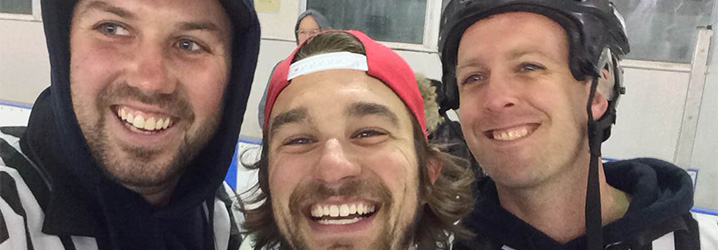With the first five games of the Beijing International Hockey League completed, the league referees took time out of their busy schedules to reflect on the progress of officiating in the league. Referee-in-Chief and resident expert on all things life-related, Greg “Fella” MacIsaac feels “The level of refereeing has gone way up in the league.”
Much of this is due to newcomers eager to get a whistle in their mouths and undergo the stringent training of the “Fella system.” With monthly training meetings on and off the ice in addition to a lively e-mail thread, refs new and experienced are picking up their game. Over the course of the first five weeks, several on ice-calls and league rules were debated in full.
Here in our monthly Ref’s Corner post, we will work to clarify on-ice calls and happenings to make our game as safe and fun as possible.
Here were this month’s five most-debated topics:
1. In week two, an overzealous Bulls player accumulated three penalties in the course of the game against the Oilers. Officials were in such disbelief over the blatant disregard for the rules of the game they lost count of the number of penalties this player received. According to the BIHL rules, this player should have immediately been ejected from the game and been considered by the disciplinary committee for a further suspension. In this instance, not a single of the three penalties was malicious or performed with intent to injure, so it would not result in a further suspension. However, regardless of the degree of maliciousness of these penalties, the player should still have been ejected from the game.
2. In another game involving the Oilers, a whistle was blown to stop play in the final minutes due to a debated face-off infraction. The Oilers center man took a faceoff in his defensive zone against his Bulls counterpart. In a bit of strategy, both players decided to miss the puck on the initial puck drop. The Oiler center immediately leaned forward and pulled the puck straight back with an open hand, with the belief that a hand pass is legal in his own defensive zone. The play was immediately whistled dead and the signal given for another faceoff in the Oilers’ defensive zone. Thomas “the rulebook” Garran was emotionless as Oilers players argued the whistle; he was steadfast in his mastery of all officiating rules. The call was brought up in the forum, proving Thomas right. The rule states that a puck cannot first be played by a hand on the faceoff.
3. Referee’s positioning: Making yourself invisible and not having wingers rip wrist shots at your face. Officials held forum with Fella to check on the correct position of a referee during game play. A referee’s goal is to remain invisible to the play, while having the greatest vision possible of the ice. This puts the referees largely along the boards skating between the blue line they call offside at, and the half boards of their offensive zone. This will occasionally result in a breakout with a referee dangerously close to play; wingers pick your heads up. There is a lot of ice out there and only two officials in black and white. Most instances a referee will not be there, but it doesn’t hurt to pick your head up before you rip a shot up the ice to no one.
4. Blow hard! New referees and a shortage of blue and red paint in China have made for some questionable whistles, or lack thereof. If an icing is close, we will let it slide. If an offside is close on our nonexistent blue lines, we are going to blow the whistle. As new officials get accustomed to the game, whistles will come quicker and louder. Players need to be patient and reminded that these referees are players themselves and out there to help create the best league experience for everybody.
5. Our final discussion was an important one: the final two minutes. We have seen the success of this year’s redraft through the consistently close games every week. Excitement is highest in the final minutes of a one-goal game. Building on the successful implementation of last year’s rule, we are continuing the stop time rule for the indefinite future. In a tie game or a game with a one goal differential, the final two minutes will be stop time. If the differential becomes more than one goal, time will once again begin to run. If a team comes back to achieve a one-goal differential in the final two minutes, it will immediately go to a stop-time situation.
Look for more in next month’s Ref’s Corner! If players have any questions or suggestions, mention it to an official outside of game time so that it can be brought up in our discussions.
We will close it out with some words from the wise Fella:
“Everyone is going to miss calls from time to time, offsides & penalties. The most important thing is to be consistent, and communicate with your partner ref. The level of refereeing has gone way up in our league because you guys, and dolls are taking it seriously and in the end making it more fun and a hell of a lot safer for everyone.”













